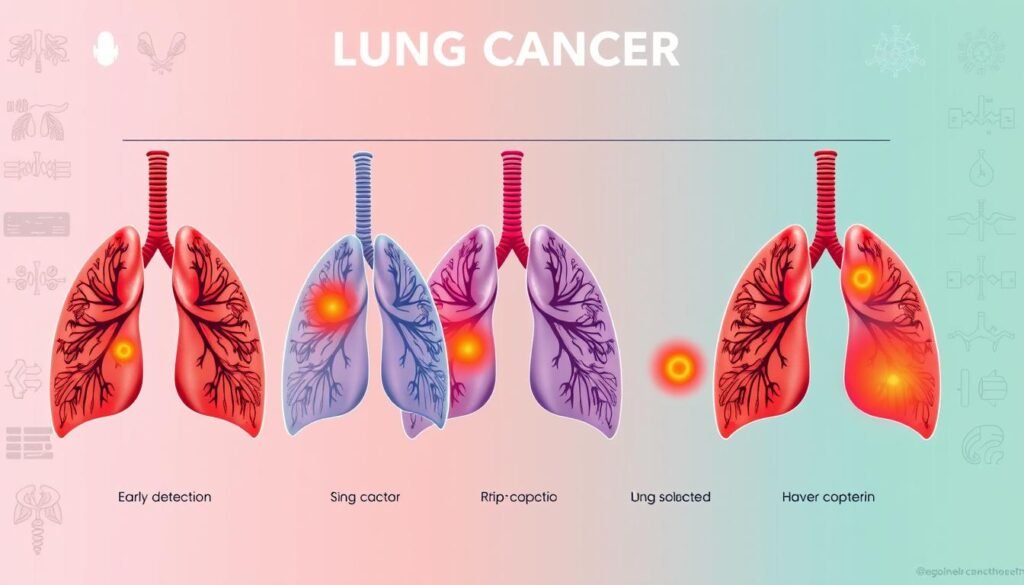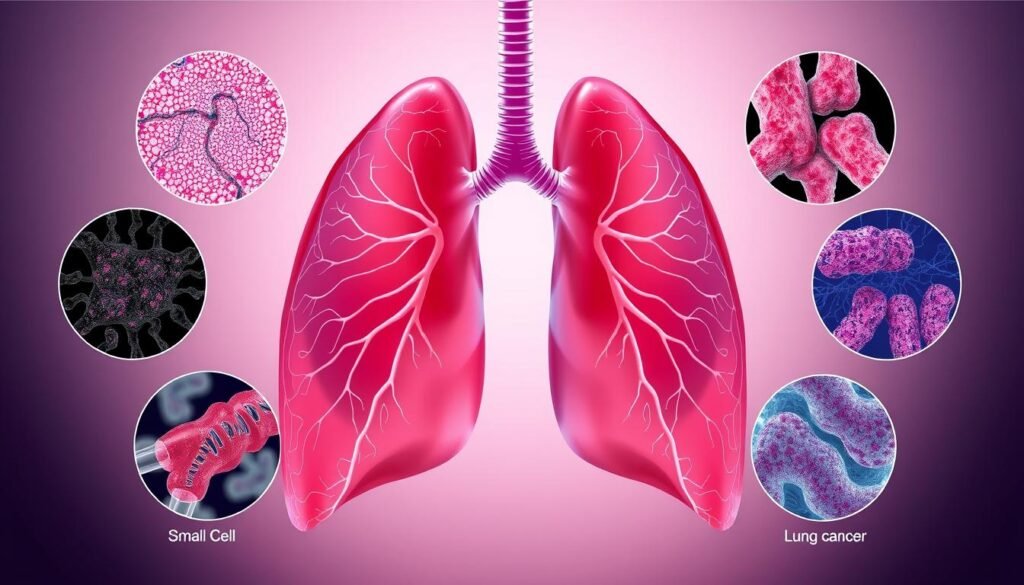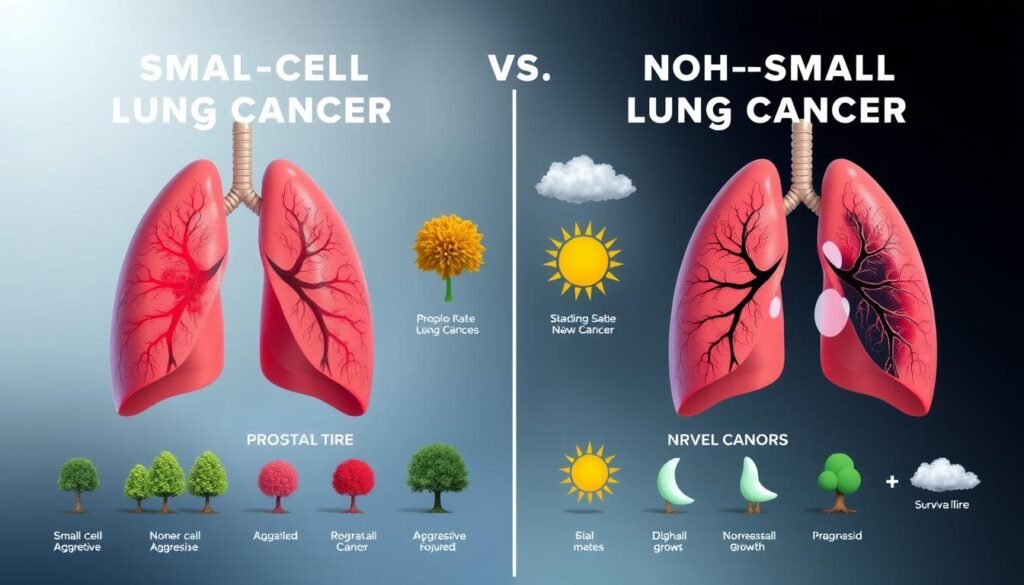Lung cancer is the top cause of cancer deaths in the United States. It accounts for 1 in 4 cancer deaths. Small Cell Lung Cancer (SCLC) and Non-Small Cell Lung Cancer (NSCLC) are the main types. NSCLC makes up about 80% to 85% of cases. This shows how crucial it is to understand the differences between SCLC and NSCLC. Each has its own symptoms and ways to treat them.
SCLC represents less than 20% of lung cancer cases. This fact underlines the importance of learning about lung cancer types. Knowing this can help spot symptoms and risks early. SCLC grows and spreads fast, whereas NSCLC appears in more common, treatable forms like adenocarcinoma and squamous cell carcinoma. Knowing these differences helps with early diagnosis and effective treatment.
Key Takeaways
- Small Cell Lung Cancer (SCLC) constitutes less than 20% of all lung cancer cases.
- Non-Small Cell Lung Cancer (NSCLC) accounts for nearly 90% of diagnoses.
- Adenocarcinoma is the most common form of NSCLC, comprising about 40% of cases.
- SCLC tends to spread more quickly than NSCLC.
- Understanding the differences can lead to better early detection and treatment outcomes.
Understanding Lung Cancer Types
Lung cancer comes in different types, mainly small cell and non-small cell lung cancer. Knowing the type is key for the right treatment. In the U.S., lung cancer is 12% of all new cancer cases each year. Knowing the type early helps doctors care for patients better.
Small cell lung cancer makes up about 15% to 20% of cases and is very aggressive. It quickly spreads from the bronchi. Most people with this cancer have a history of smoking, showing a strong link between smoking and this cancer.
Non-small cell lung cancer is more common, making up about 80% to 85% of cases. It includes adenocarcinoma, squamous cell carcinoma, and large cell carcinoma. Each subtype is different, making it important to identify correctly. Adenocarcinoma starts in gland cells, while squamous cell carcinoma starts in flat cells.
Knowing the differences between lung cancer types helps in treatment choices. Non-small cell lung cancer grows slower and might not show symptoms early, unlike small cell lung cancer.
| Lung Cancer Type | Percentage of Cases | 5-Year Survival Rate (Localized) | 5-Year Survival Rate (Distant) |
|---|---|---|---|
| Small Cell Lung Cancer | 15-20% | 30% | 3% |
| Non-Small Cell Lung Cancer | 80-85% | 65% | 9% |
Understanding these types of lung cancer is crucial for diagnosis and treatment. It’s important for doctors to know all details to provide the best care.
Small Cell Lung Cancer Overview
Small cell lung cancer (SCLC) is a fast-growing type of lung cancer. It’s also known as oat cell cancer. This cancer usually starts in the airways and can quickly spread to important organs like the liver and brain. About 15% of all lung cancer cases worldwide are SCLC. This cancer is hard to deal with because it’s usually found at an advanced stage.
There are two main kinds of SCLC: small cell carcinoma and combined small cell carcinoma. Combined small cell carcinoma has traits of SCLC and non-small cell carcinoma (NSCLC). Under the microscope, SCLC looks very aggressive. It grows fast and has lots of dead tissue. Because SCLC tumors are similar to neuroendocrine cells, they have specific markers.
People with small cell lung cancer often have changes in important genes like p53 and Rb. These changes make the cancer grow faster. Even though fewer people are getting SCLC now than 30 years ago, it’s still a big problem. This is because it usually has a bad outcome. The chance of living more than 5 years after being diagnosed is less than 7%. This is why it’s crucial to catch it early and know the signs, such as a constant cough or chest pain.
The main treatments for SCLC include chemotherapy and radiation therapy. If the disease hasn’t spread much, patients might get both treatments at the same time. But if the disease has spread a lot, they might only get chemotherapy to relieve symptoms. Once the disease advances, the average life expectancy with further chemotherapy is about 4 to 5 months. This highlights the need for more research and better treatments.
For more info on the signs of small cell lung cancer, check out the warning signs and symptoms page. It talks about signs that the disease is getting serious.
Non-Small Cell Lung Cancer Overview
Non-small cell lung cancer (NSCLC) is the most common lung cancer type. It makes up about 85% of all cases. NSCLC includes a few different kinds, like adenocarcinoma, squamous cell carcinoma, and large cell carcinoma. Adenocarcinoma is the most seen lung cancer in the U.S. Knowing these types helps doctors diagnose and treat it right.
NSCLC grows slower than small cell lung cancer, so finding it early is key. But, many people don’t know they have it until it’s pretty advanced. This fact makes early screenings very important. Catching the cancer early can make it easier to handle. Health groups are working to make more people aware of the signs and how to get screened.
The subtypes of NSCLC are different in how they act and how doctors treat them:
| Subtype | Key Features | Treatment Options |
|---|---|---|
| Adenocarcinoma | Most common subtype, often associated with non-smokers | Surgery, chemotherapy, targeted therapy |
| Squamous Cell Carcinoma | Frequently linked with smoking; grows in central lung areas | Surgery, chemotherapy, radiation therapy |
| Large Cell Carcinoma | Least common, aggressive growth pattern | Surgery, chemotherapy, immunotherapy |
Treating NSCLC well means knowing each subtype’s details, as tailored treatments help a lot. Ongoing research is trying to better survival rates and lessen the disease’s effects.
The Difference Between Small Cell Lung Cancer and Non-Small Cell Lung Cancer
It’s vital to know the differences between small cell and non-small cell lung cancer for effective care. These cancers vary greatly in characteristics and how they act, affecting how patients are treated. This knowledge helps doctors make the best treatment choices for their patients.
Characteristics of Small Cell Lung Cancer
Small cell lung cancer (SCLC) makes up 10% to 15% of all lung cancer cases. It’s often seen in heavy smokers. SCLC is known for being very aggressive and spreading quickly, making it hard to catch early.
This cancer type grows from small, round cells that multiply fast. At the time of diagnosis, it’s common for the disease to have spread widely. This makes choosing the right treatment more difficult.
Characteristics of Non-Small Cell Lung Cancer
Non-small cell lung cancer (NSCLC) represents about 85% of lung cancer cases. Its cells are bigger than those seen in SCLC. NSCLC has different kinds, like adenocarcinoma, squamous cell carcinoma, and large cell carcinoma. Each type needs its own treatment plan.
NSCLC grows slower than SCLC and is often found before it has spread. Knowing each lung cancer type’s specific characteristics helps doctors create personalized treatments. These might include surgery or new medicines.
Different symptoms and treatments exist for each lung cancer type. It’s very important for doctors and patients to understand these differences. To learn more about treatment options, explore this resource.
Lung Cancer Symptoms
Lung cancer signs can be different for everyone. Catching these signs early can really help treatment and health. Knowing the signs of small cell lung cancer and non-small cell lung cancer can lead to timely help.
Common Symptoms of Both Types
People with small or non-small cell lung cancer often share symptoms. These include:
- Coughing that gets worse
- Feeling out of breath, especially when active
- Chest pain that feels sharp or dull
- Coughing up blood or rust-colored spit
- Losing appetite and weight
- Feeling tired and weak
Symptoms Unique to Small Cell Lung Cancer
Small cell lung cancer symptoms can be different from non-small cell lung cancer. Some distinct signs are:
- Brain-related symptoms like headaches or seizures from cancer spread
- Horner’s syndrome, with drooping eyelids and small pupils
- Strange hormone levels causing conditions like SIADH
Symptoms Unique to Non-Small Cell Lung Cancer
People with non-small cell lung cancer might notice subtle symptoms at first. They can include:
- Long-lasting cough that doesn’t get better
- Wheezing or voice changes
- Signs of a lung infection like fever and shivering
Knowing these symptoms can help catch lung cancer early. This can lead to quicker treatment. It’s important to know about these symptoms for better health and wellbeing.
| Symptom | Small Cell Lung Cancer | Non-Small Cell Lung Cancer |
|---|---|---|
| Coughing | Persistent, with possible blood | Worsening, does not improve |
| Shortness of Breath | During physical activities | Initially subtle, may worsen over time |
| Pain in the Chest | Sharp or dull | Varies, may be persistent |
| Neurological Symptoms | Headaches, seizures (metastasis) | Generally absent |
| Weight Loss | Commonly reported | Loss of appetite noted |
Lung Cancer Stages
It’s vital to understand lung cancer stages to plan treatment. Small cell lung cancer falls into two stages: limited and extensive. The limited stage means cancer is only in one lung and may reach nearby nodes. Extensive stage shows it has spread more widely.
Staging for Small Cell Lung Cancer
For small cell lung cancer, we have two main stages. The limited stage might allow for surgery to remove the tumor. But the extensive stage is tougher, needing widespread chemotherapy or radiation.
Staging for Non-Small Cell Lung Cancer
Non-small cell lung cancer uses a five-stage system, from 0 (localized) to IV (widely spread). Stages I and II are divided further, considering tumor size and lymph node involvement. This detailed system helps decide on treatments like surgery or chemotherapy.

Understanding these stages helps pick the right treatment, affecting prognosis and care quality. For deeper insights on lung cancer stages and treatments, visit this resource.
| Type of Lung Cancer | Staging | Treatment Options |
|---|---|---|
| Small Cell Lung Cancer | Limited, Extensive | Surgery, Chemotherapy, Radiation Therapy |
| Non-Small Cell Lung Cancer | Stage 0 to IV | Surgery, Radiofrequency Ablation, Chemotherapy, Immunotherapy |
Lung Cancer Risk Factors
Lung cancer risk factors include many elements that increase the chance of getting this serious disease. The most critical factor is the link between smoking and lung cancer. About 80% of lung cancer deaths are caused by smoking. This is even truer for small cell lung cancer (SCLC). Knowing these risks helps with prevention and personal health checks.
Smoking as a Major Risk
Smoking is the top reason behind lung cancer, especially small cell lung cancer. If you smoke cigarettes, your risk skyrockets. Studies show that around 90% of lung cancer cases are due to smoking. Being around secondhand smoke is also dangerous. It is the third leading cause of lung cancer in the U.S. Plus, smokers who take beta-carotene supplements might increase their lung cancer risk even more.
Environmental and Occupational Risk Factors
Being exposed to certain environments and jobs also ups your lung cancer risk. Radon gas in homes is the second highest cause of lung cancer for nonsmokers. Asbestos exposure is very risky too, especially for smokers working in certain industries. Other dangers include arsenic in water in some areas. Having lung cancer in your personal or family history makes you more susceptible. It shows why being aware of these environmental factors matters.
Lung Cancer Diagnosis
Getting the right lung cancer diagnosis is key to managing the disease well. It significantly shapes the treatment plan. Doctors use many tests to confirm lung cancer. These include X-rays, CT scans, and sputum tests. Each test gives important information about the patient’s health, helping doctors provide the best care.
Diagnostic Tests and Procedures
Doctors have a variety of diagnostic tests to detect lung cancer early. They use imaging studies like:
- X-rays
- CT scans
- Positron emission tomography (PET) scans
These tests help see any unusual areas in the lungs. Examining sputum can also show cancer cells from lung mucus. If these tests suggest cancer, more detailed checks may be needed.
Importance of Biopsy
A biopsy in lung cancer confirms the diagnosis. This test takes a tiny piece of lung tissue to look for cancer cells. It also helps identify the type of cancer. Biopsy methods include:
- Needle biopsy
- Bronchoscopy
- Surgical biopsy
The results from a biopsy help doctors decide on the best treatment. It gives them details about the tumor. Knowing the specific kind of lung cancer allows for more accurate treatment. Patients can then get the help and advice they need. For more about the differences in lung cancer types, check out this small-cell versus non-small-cell comparison.

Lung Cancer Treatment Options
Lung cancer treatments differ a lot between small cell lung cancer (SCLC) and non-small cell lung cancer (NSCLC). It’s important for patients and caregivers to understand the right treatments for each type. This knowledge helps in making wise choices.
Treatment for Small Cell Lung Cancer
Small cell lung cancer treatments mainly use chemotherapy and radiation. This type of cancer spreads fast, so it’s vital to act quickly. Chemotherapy is the key approach but often goes hand in hand with radiation to boost success.
There are clinical trials too. They offer new treatments that test different drugs and methods, aiming to get better results. Some look into acupuncture and dietary supplements as extra help. These can assist in managing symptoms and improving quality of life.
Treatment for Non-Small Cell Lung Cancer
For non-small cell lung cancer, treatment options are wider. Choices may include surgery, chemotherapy, radiation, targeted therapies, or a mix of these. Targeted therapy is a big leap forward. It uses drugs that go after cancer cells with specific genetic markers.
Trying clinical trials might be an option for some. These trials explore new therapies that are still under study. Tailoring treatments to fit each patient’s unique situation is crucial. It ensures the methods chosen align well with the patient’s health situation and needs.
Lung Cancer Prognosis
Understanding lung cancer prognosis is crucial. It helps know the likely outcomes and the success of treatments. The outlook for small cell lung cancer (SCLC) and non-small cell lung cancer (NSCLC) differs a lot. This knowledge is vital for both patients and healthcare workers.
Survival Rates for Small Cell Lung Cancer
Small cell lung cancer acts quickly and usually has a worse outlook than non-small cell lung cancer. Survival rates are a proof of this, with limited-stage SCLC having better outlooks than extensive-stage SCLC. Sadly, only 7% survive for five years with SCLC. Losing over 5% of body weight before treatment can worsen this. How well someone can do daily activities also affects their outlook. People doing better day-to-day often have a better chance.
Survival Rates for Non-Small Cell Lung Cancer
Non-small cell lung cancer comes in many types and stages, which means survival rates vary. Those found in early stages (0 and 1) might survive five years 64% of the time. But, this drops to as low as 8% for later stages (2, 3, or 4). Being healthy helps a lot; it means you can get surgery and handle chemo and radiation better, which improves chances. Changes in the cancer cells’ genes also play a role in how well treatments work for both SCLC and NSCLC. Living healthily and taking care of your lungs and heart can make a big difference in your prognosis.

| Cancer Type | Stage | 5-Year Survival Rate |
|---|---|---|
| Small Cell Lung Cancer | Limited Stage | Higher than Extensive Stage |
| Small Cell Lung Cancer | Extensive Stage | 7% |
| Non-Small Cell Lung Cancer | Localized (Stage 0 & 1) | 64% |
| Non-Small Cell Lung Cancer | Advanced (Stage 2, 3, & 4) | 8% |
Conclusion
Lung cancer comes in two main types: small cell lung cancer (SCLC) and non-small cell lung cancer (NSCLC). NSCLC makes up about 80% of all cases. Treatments like Sotorasib show promise, especially for those with certain gene mutations like KRAS.
SCLC, on the other hand, accounts for 20% of cases. It’s more aggressive and often comes back after treatment. This shows why it’s key to be aware of lung cancer.
It’s vital to know the symptoms, risks, and treatment for each type of lung cancer. This knowledge can improve lives and outcomes. There’s a big difference in survival rates between SCLC and NSCLC patients.
Efforts in educating patients and early detection are crucial. They lead to better care and support for those facing lung cancer.
There are always new findings in cancer treatment needing more research. For those interested in the latest therapies, visit Care Your Lungs. Here, you can learn about how new treatments are making a difference.